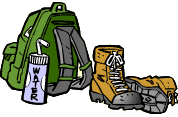HIKING ACTIVITY CARD
Parts of the Body Worked

Upper & Lower Legs

Hips & Butt

Abs

Shoulders & Neck

Gear Up
First, you’ll need a good pair of shoes and thick socks designed for this type of activity. You can start with some sturdy sneakers with thick bottoms. When you begin to take on more difficult trails, try a pair of hiking boots, and make sure they fit! Also, get a backpack or fanny pack to carry all of your hiking supplies. Dress in layers and bring along a waterproof jacket with a hood in case you get caught in the rain. And don’t forget a hat, sunscreen, and sunglasses because the higher you hike, the more dangerous the sun’s rays become. Want to read more on protecting yourself from the sun?
To keep hiking fun, you always need to be prepared to beat problems that could happen while you’re out, like finding the trail if you get lost or stuck in bad weather. Make sure you bring a map of the area you’ll be hiking in and a sturdy compass. Don’t know how to use a compass? Check this out to learn how. You’ll also need to bring plenty of water and extra food, like sports bars or trail mix, in case you have to stay out late and get hungry. The adults on your hike should bring a box of waterproof matches and an Army-style knife. A flashlight and extra batteries will help you find your way if you end up out after dark. Finally, you’ll need to bring a first aid kit, in case someone gets hurt during your hike.
Play it Safe
Prep. Get in shape before you head out on your hike. Try walking around your neighborhood with your pack loaded with five pounds more gear than you’ll actually carry on your hike. If that goes well, plan a short hike to test your abilities on the trail.
Buddies. Take a friend and an adult along on your hike. That way you can look out for each other and you’ll have people to talk to! Also, be sure to let someone who’s not going know where you’ll be hiking and what time you’ll be back.
H2O. Carry lots of water even if you are only planning a short hike. For warm-weather hikes, bring six to eight quarts of water per day. In the cold weather or higher elevations, you can be safe with half that amount. Whenever you are near water, make sure you wet yourself down. Dampen a bandana and wipe your face, neck, and arms or wrap it around your head while you hike. Want to read more about keeping your cool?
Blisters and more. To prevent blisters, try spraying your feet with an anti-perspirant before heading out. Bring extra pairs of socks that you can change into if your feet get wet or sweaty — if they aren’t made of cotton, they’ll keep your feet drier. Once you’re on the trail, stop as soon as you feel a “hot spot” on your feet and apply special type of bandage called “moleskin” to the sore area. Also, try using a hiking stick to keep some pressure off of your legs and knees.
Buzz. Don’t get bugged by bugs. Protect yourself from bites and stings by using a bug repellant that includes DEET. Repellents that contain DEET are the most effective, but make sure you rub them on according to the directions. A good rule of thumb from the experts is that kids should use repellents with less than 10% DEET. Get your parents to help you put it on your face so you don’t get it in your mouth or eyes. And wash your hands after you apply it. Remember that stuff that smells good to you smells good to bugs too, so don’t use scented shampoos or lotions before hiking.
Weather watcher. When it’s hot, pick trails that are shaded and run near streams. If you need to hike uphill in the sun, first soak yourself down to stay cool. You can also try wearing a wet bandana around your head or neck. Also, try to stay out of cotton clothes. Keep yourself out of bad weather by checking forecasts before you hike and watching the skies once you’re out on the trail. During lightening storms, head downhill and away from the direction of the storm, and then squat down and keep your head low.
Keep it yummy. To stay healthy on your hike, you’ll need to know how to keep your food and water safe. Remember the four C’s: contain, clean, cook, and chill.
How to Play
Take a hike! No, really, take the time to go hiking. Hiking with your friends or family is a great chance to get outdoors, breathe some fresh air, and get active. It’s easy to get started. Just look for a trail in a national park near you!
For your first day hike (hiking for a day or less without camping overnight), choose a safe, well-marked trail that doesn’t have too many steep climbs. Otherwise, you’ll get tired too early and won’t make it as far as you want to go. Each time you go hiking, try going a little farther and take a slightly steeper trail. Before you know it you’ll be hiking the Appalachian Trail — a 2,167-mile trail that goes all the way from Maine to Georgia!
Fun Facts
In the year 2000, 67 million people went hiking.
America’s National Parks have more that 12,000 miles of trails.
The Appalachian Trail starts in northern Georgia and continues through South Carolina, North Carolina, Tennessee, Virginia, Maryland, Pennsylvania, New Jersey, New York, Connecticut, Massachusetts, Vermont, and ends in Maine at Mt. Katahdin, Baxter Peak, Baxter State Park.
Related Links
- Page last reviewed: May 9, 2015
- Page last updated: May 9, 2015
- Content source:



 ShareCompartir
ShareCompartir